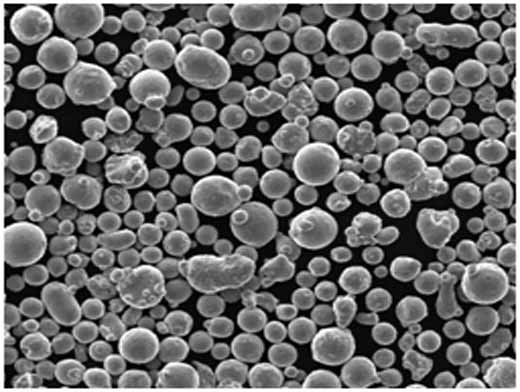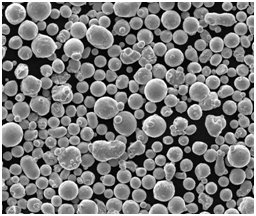Introdução
Pó CuAl10 é um pó metálico de alto desempenho feito de uma liga de cobre (Cu) e alumínio (Al), geralmente contendo cerca de 10% de alumínio por peso. Conhecido por suas excelentes propriedades mecânicas e resistência à corrosão, o pó CuAl10 é amplamente utilizado em vários setores, desde o aeroespacial até o eletrônico e a manufatura aditiva. Se estiver se perguntando o que torna o CuAl10 tão especial, continue lendo - vamos nos aprofundar em sua composição, propriedades e aplicações exclusivas.
Composição do pó de CuAl10
Compreender a composição do pó CuAl10 é fundamental para entender por que ele é um material tão versátil. Essa liga combina a condutividade do cobre e as propriedades de leveza do alumínio, o que a torna ideal para aplicações que exigem força e resistência à corrosão sem muito peso adicional.
| Elemento | Porcentagem por peso | Propriedades contribuídas |
|---|---|---|
| Cobre (Cu) | 90% | Proporciona condutividade e ductilidade |
| Alumínio (Al) | 10% | Adiciona resistência, propriedade de leveza |
| Oligoelementos | <1% | Estabiliza e ajusta o desempenho |

Processo de fabricação do pó CuAl10
Há várias maneiras de fabricar o pó CuAl10, cada uma delas afetando as características finais do material. Vejamos os principais métodos de fabricação e como eles influenciam propriedades como tamanho de partícula, densidade e pureza.
| Método de fabricação | Descrição do processo | Características resultantes |
|---|---|---|
| Atomização de gás | Liga CuAl10 fundida pulverizada com gás inerte | Partículas finas e esféricas; alta pureza |
| Atomização de água | Liga pulverizada com água a alta pressão | Forma irregular; econômica; densa |
| Atomização por plasma | Liga exposta a arco de plasma para alta precisão | Partículas ultrafinas; tamanho altamente controlado |
A escolha do método de fabricação correto depende muito da aplicação pretendida. Por exemplo, o pó atomizado a gás é preferido para impressão 3D devido ao seu formato esférico de partícula e fluxo consistente.
Características do pó CuAl10
A combinação exclusiva de cobre e alumínio no pó CuAl10 lhe confere um equilíbrio entre resistência mecânica, resistência à corrosão e condutividade térmica. Abaixo estão algumas das principais características que definem o desempenho dessa liga.
| Propriedade | Valor | Importância |
|---|---|---|
| Densidade | ~7,3 g/cm³ | Suficientemente leve para aplicações aeroespaciais |
| Ponto de fusão | 1,030°C | Adequado para ambientes de alta temperatura |
| Resistência à tração | Até 280 MPa | Oferece durabilidade para usos estruturais |
| Condutividade térmica | ~125 W/mK | Excelente dissipação de calor, útil em eletrônicos |
Essas propriedades tornam o CuAl10 Powder ideal para aplicações em que o equilíbrio entre resistência e peso é crucial e em que a dissipação de calor desempenha um papel fundamental.
Tipos e modelos de Pó CuAl10
O pó CuAl10 está disponível em vários modelos, cada um adaptado a aplicações específicas por meio do ajuste de parâmetros como tamanho e pureza das partículas. Veja a seguir um detalhamento de alguns modelos comumente usados de pó de CuAl10.
| Modelo | Faixa de tamanho de partícula | Nível de pureza | Uso comum |
|---|---|---|---|
| CuAl10-40S | 40-60 mícrons | 99% | Processos de sinterização |
| CuAl10-25F | 25-45 mícrons | 99.5% | Moldagem por injeção de metal (MIM) |
| CuAl10-80M | 80-100 mícrons | 98% | Revestimentos por spray térmico |
| CuAl10-15P | 10-20 mícrons | 99.9% | Impressão 3D, alta precisão |
| CuAl10-Nano | <1 mícron | 99.8% | Tintas condutoras, eletrônicos |
| CuAl10-MAX300 | 250-300 mícrons | 98.5% | Aplicações estruturais |
| CuAl10-HF45 | 45-75 mícrons | 99.7% | Aquecimento indutivo de alta frequência |
| CuAl10-XP40 | 40-60 mícrons | 99% | Manufatura aditiva |
| CuAl10-LowO2 | 40-60 mícrons | Baixa Oxidação | Aplicações sensíveis à oxidação |
| CuAl10-HP20 | 20-30 mícrons | 99.5% | Material de enchimento de solda de alto desempenho |
Cada modelo oferece vantagens distintas dependendo da aplicação, portanto, a seleção da variante correta garante desempenho e eficiência ideais.









Aplicações e Usos do Pó de CuAl10
O Pó de CuAl10 encontra aplicações em diversas indústrias devido às suas propriedades versáteis. De componentes aeroespaciais complexos à gestão térmica em eletrônica, vamos ver como o Pó de CuAl10 é aplicado em vários campos.
| Área de aplicação | Papel do Pó de CuAl10 | Modelos Notáveis |
|---|---|---|
| Manufatura Aditiva | Permite peças impressas em 3D precisas, leves e duráveis | CuAl10-P15, CuAl10-40S |
| Aeroespacial | Usado em componentes que precisam de alta resistência e baixo peso | CuAl10-MAX300, CuAl10-25F |
| Eletrônicos | Excelente para dissipadores de calor, tintas condutoras | CuAl10-Nano, CuAl10-LowO2 |
| Revestimentos por spray térmico | Fornece camadas protetoras térmicas e resistentes à corrosão | CuAl10-80M, CuAl10-40S |
| Moldagem por injeção de metal | Adequado para criar formas pequenas e complexas | CuAl10-25F, CuAl10-15P |
Seja na fabricação aditiva de ponta ou em revestimentos por pulverização térmica, o Pó de CuAl10 se destaca devido à sua resistência e condutividade.
Especificações Técnicas, Tamanhos e Padrões para Pó CuAl10
Atender aos padrões da indústria é fundamental para pós metálicos como o CuAl10. A conformidade com as especificações ASTM e ISO garante qualidade e compatibilidade com outros materiais.
| Especificação | Padrão (ISO/ASTM) | Tamanho da partícula (mícrons) | Pureza |
|---|---|---|---|
| Manufatura Aditiva | ISO/ASTM 52900 | 10-100 | 99.5% |
| Sinterização | ASTM B212 | 20-60 | 99% |
| Moldagem por injeção de metal | ASTM B243 | 25-45 | 99.5% |
| Revestimentos por spray térmico | ISO 14919 | 50-100 | 98% |
Fornecedores, Preços e Disponibilidade
O Pó de CuAl10 é oferecido por vários fornecedores em todo o mundo, cada um atendendo a várias indústrias e requisitos.
| Fornecedor | Localização | Preço (USD/kg) | Prazo de entrega | Especialização |
|---|---|---|---|---|
| PowderMet Inc. | EUA | $40-$60 | 2 a 4 semanas | Pós de alta pureza |
| Global Alloys Co. | Alemanha | $50-$70 | 3-6 semanas | Pedidos em massa de grau industrial |
| Nippon Alloys Ltd. | Japão | $45-$65 | 2 a 3 semanas | Pós nano e de alta precisão |
| EuroPowders GmbH | Alemanha | $55-$75 | 4-6 semanas | Aplicações térmicas e estruturais |
O preço depende de fatores como modelo, pureza e quantidades de compra em massa. Os principais fornecedores costumam oferecer descontos para pedidos em massa e tamanhos especiais.
Vantagens e Limitações do Pó de CuAl10
O Pó de CuAl10 oferece inúmeras vantagens, mas não está isento de desafios. Compreender ambos pode ajudar a tomar decisões informadas de compra e aplicação.
| Vantagens | Limitações |
|---|---|
| Forte e resistente à corrosão | Mais caro em comparação com ligas básicas |
| Leve, mas durável | Não é ideal para oxidação em altas temperaturas |
| Excelente condutividade | Fornecedores limitados para pós de nano grau |
| Disponível em vários tamanhos de partículas | Alguns modelos têm um prazo de entrega mais longo |
Comparação Pó CuAl10 para Ligas Semelhantes
Curioso sobre como o CuAl10 se compara a ligas semelhantes como CuAl8 ou CuAl15? Aqui está uma comparação rápida:
| Liga metálica | Teor de Cu | Conteúdo Al | Adequação do Caso de Uso | Custo |
|---|---|---|---|---|
| CuAl10 | 90% | 10% | Aplicações equilibradas | Moderado |
| CuAl8 | 92% | 8% | Alta ductilidade, resistência moderada | Inferior |
| CuAl15 | 85% | 15% | Alta resistência à corrosão | Ligeiramente superior |

Perguntas frequentes
| Pergunta | Resposta |
| Para que serve o Pó de CuAl10? | O Pó de CuAl10 é usado em impressão 3D, eletrônicos e aeroespacial por sua resistência, condutividade e resistência à corrosão. |
| Como o Pó de CuAl10 é feito? | É feito principalmente por atomização a gás, água ou plasma, cada método produzindo diferentes características de partículas. |
| O Pó de CuAl10 é caro? | Os preços variam, mas geralmente é mais caro do que ligas mais simples devido às suas propriedades especializadas. |
| O Pó de CuAl10 pode ser usado em soldagem? | Sim, certos modelos como o CuAl10-HP20 são adequados para materiais de enchimento de solda. |
| Como o CuAl10 se compara ao cobre puro? | O CuAl10 é mais leve e resistente devido ao seu teor de alumínio, mas oferece um pouco menos de condutividade em comparação com o cobre puro. |
Conclusão
Pó CuAl10 continua sendo um material muito procurado devido à sua durabilidade, resistência à corrosão e adaptabilidade em várias indústrias. Da impressão 3D à aeroespacial e eletrônica, o Pó de CuAl10 é essencial em aplicações onde resistência, condutividade e resistência à corrosão são críticas. À medida que as técnicas de fabricação evoluem, a gama de modelos e aplicações para o Pó de CuAl10 continua a crescer, solidificando seu lugar como uma liga versátil e de alto desempenho na engenharia moderna.

